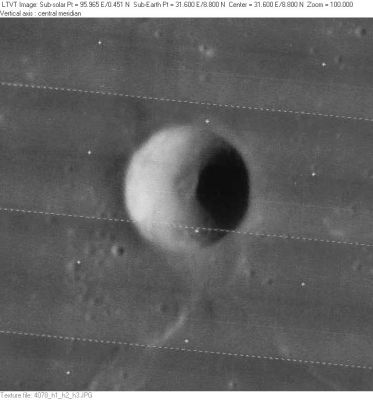Sinas
Contents
Sinas
(formerly Sina)
|
Lat: 8.8°N, Long: 31.6°E, Diam: 11 km, Depth: 2.26 km, Rükl: 36 |
LO-IV-078-h.
Note the curious half disc-shaped shallow crater (or rather: plateau) at the southern part of the rim of Sinas. Was this disc-shaped plateau once a complete crater?
A much more pronounced kind of half appendage is noticeable at crater Norman in Oceanus Procellarum.
Images
LPOD Photo Gallery Lunar Orbiter Images Apollo Images
- Apollo 11's oblique north-northeast looking orbital view of Mare Tranquillitatis (AS11-42-6317) shows both Sinas and Sinas E, with a system of nearby wrinkle ridges, and a dome field. Note the curious "half disc-shaped plateau" at the south-southeastern part of Sinas's rim. The LPI's description below the photograph ("Maskelyne B") and the coordinates are an error.
- Sinas was also photographed during the mission of Apollo 8, see: AS8-13-2346 (Sinas is the larger one of the two pronounced bowl-shaped craters).
- Research Apollo 8 and Apollo 11 photographs: Danny Caes (- DannyCaes Nov 7, 2015).
Maps
(LAC zone 61A4) LAC map Geologic map LTO map
Description
Description: Wikipedia
Additional Information
Depth data from Kurt Fisher database
- Arthur, 1974: 2.26 km
- Westfall, 2000: 2.26 km
- Viscardy, 1985: 2.3 km
- Sinas & Sinas H are thermal anomaly craters, implying youthful ages - Moore et al, 1980
- A curious "half disc-shaped plateau" is noticeable at the south-southeastern part of Sinas's rim, which is an interesting target for dedicated telescopic observers of the Mare Tranquillitatis region! - DannyCaes Sep 15, 2009
- About 2 degrees east-southeast of Sinas (northeast of Sinas A, about halfway between Sinas A and Sinas G) is the location of a Skylight with diameter of 100 meter (source orbital photograph: LRO). This Skylight-pit is also detectable on several of Apollo 15's orbital mapping/metric Fairchild-camera photographs of the Sinas region.- DannyCaes Jul 18, 2010
Region of small bulbous "topsy-turvy" dimple craterlet appearances north of Sinas E
I don't know if this sort of surface formation is already discovered or described somewhere: a mix of normal dimple craterlets with appearances of "topsy-turvy" craterlets in between, looking like small domes all over. So it looks in the region just north of the bowl-shaped crater Sinas E on the High-Resolution NAC images made by the Lunar Reconnaissance Orbiter. See this example: http://bit.ly/2ummG1P
- DannyCaes Jul 4, 2017
Nomenclature
- Named (according to the IAU Planetary Gazetteer) for Simon Sinas(1810-1876), a Greek benefactor. Simon Sinas was the son of Greek benefactor and diplomat Baron Georgios (George) Sinas (1783-1856). George Sinas had contributed the money and much of the energy that made possible the construction of the National Observatory of Athens. After the Baron's death, Simon, and later his wife, continued the Sinas family tradition of financially supporting that institution. - Jim Mosher
- In her Collated List, Mary Blagg noted that this crater (catalog entry 260), was called Jansen C by both Neison and Mädler, but Sina by Schmidt (the Wikipedia article mentions that Simon Sinas also went by the name "Simon von Sina").
- The feature entered the original IAU nomenclature of Named Lunar Formations as Sina (attributed to Schmidt).
- According to Whitaker (p. 224) the name was introduced by Schmidt (who worked in Greece) as Sina, but the spelling was changed to Sinas in the original IAU nomenclature of Blagg and Müller. - Jim Mosher
- Kuiper et al., in Table III to their Photographic Lunar Atlas, expressed their opinion that Schmidt had misspelled the name of his benefactor and recommended changing the spelling to Sinas. Their recommendation was approved by the IAU in 1961.
- They might well be right, but I am unaware of any documentation establishing how the compilers of the IAU Planetary Gazetteer determined that Schmidt's "Sina" was meant to honor Simon Sinas rather than George Sinas. Schmidt arrived at Athens Observatory in 1858, two years after the death of the elder Sinas; the map on which Blagg saw the name was published in 1878, two years after the death on the younger Sinas. It would seem possible Schmidt might have been honoring the family that supported him rather than any particular member of it. - Jim Mosher
LPOD Articles
Bibliography
